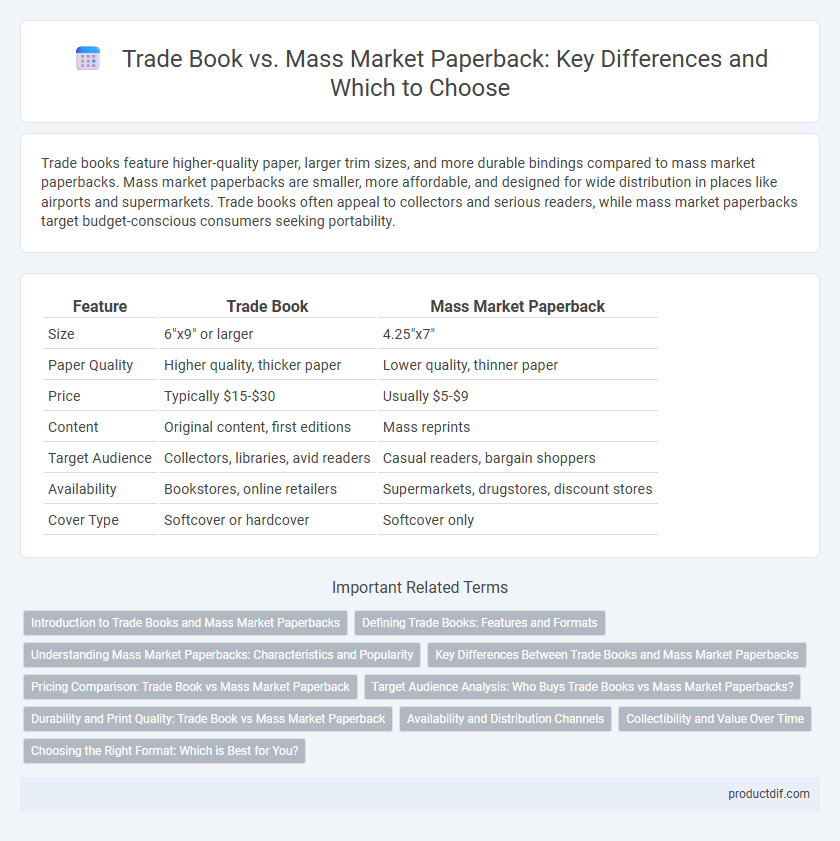Trade books feature higher-quality paper, larger trim sizes, and more durable bindings compared to mass market paperbacks. Mass market paperbacks are smaller, more affordable, and designed for wide distribution in places like airports and supermarkets. Trade books often appeal to collectors and serious readers, while mass market paperbacks target budget-conscious consumers seeking portability.
Table of Comparison
| Feature | Trade Book | Mass Market Paperback |
|---|---|---|
| Size | 6"x9" or larger | 4.25"x7" |
| Paper Quality | Higher quality, thicker paper | Lower quality, thinner paper |
| Price | Typically $15-$30 | Usually $5-$9 |
| Content | Original content, first editions | Mass reprints |
| Target Audience | Collectors, libraries, avid readers | Casual readers, bargain shoppers |
| Availability | Bookstores, online retailers | Supermarkets, drugstores, discount stores |
| Cover Type | Softcover or hardcover | Softcover only |
Introduction to Trade Books and Mass Market Paperbacks
Trade books typically feature higher-quality paper, larger trim sizes, and often include hardcover editions, appealing to avid readers and collectors. Mass market paperbacks are smaller, more affordable, and designed for wide distribution in places like airports and supermarkets, targeting casual readers seeking portable options. The distinction influences publishing formats, pricing strategies, and marketing approaches within the book industry.
Defining Trade Books: Features and Formats
Trade books are distinguished by their larger dimensions, higher-quality paper, and more durable binding compared to mass market paperbacks, which are smaller and printed on lower-grade paper. They often feature more sophisticated cover designs and are targeted at readers seeking a premium reading experience. Trade books typically include hardcover and larger paperback editions, catering to bookstores and libraries, while mass market paperbacks prioritize affordability and portability for mass distribution.
Understanding Mass Market Paperbacks: Characteristics and Popularity
Mass market paperbacks are smaller, more affordable editions primarily designed for widespread distribution in places such as airports, supermarkets, and drugstores. Characterized by their compact size and lower-quality paper, these books prioritize accessibility and convenience, appealing to a broad audience seeking budget-friendly options. Their popularity stems from high print runs and genre fiction dominance, particularly in romance, mystery, and science fiction markets.
Key Differences Between Trade Books and Mass Market Paperbacks
Trade books are typically larger in size, printed on higher-quality paper, and feature more durable binding compared to mass market paperbacks, which are smaller, more affordable, and designed for widespread distribution. Trade books often include hardcover editions and target niche or literary markets, while mass market paperbacks are usually softcover, produced for broad commercial appeal and portability. Pricing reflects these differences, with trade books priced higher due to superior production values and targeted marketing strategies.
Pricing Comparison: Trade Book vs Mass Market Paperback
Trade books typically carry higher price points due to superior paper quality, larger page size, and more durable binding compared to mass market paperbacks. Mass market paperbacks are produced in bulk with lower production costs, allowing publishers to sell them at a significantly lower price. Consumers often choose mass market paperbacks for affordability, while trade books attract readers seeking premium presentation and collectible value.
Target Audience Analysis: Who Buys Trade Books vs Mass Market Paperbacks?
Trade books primarily attract avid readers, literary enthusiasts, and collectors who prioritize quality content and presentation, often seeking niche or specialized genres. Mass market paperbacks target casual readers looking for affordable, widely available titles, including popular fiction and genre novels, appealing to a broader demographic. Consumer preferences for trade books emphasize durability and aesthetic appeal, while mass market paperbacks are favored for convenience and budget-conscious purchasing.
Durability and Print Quality: Trade Book vs Mass Market Paperback
Trade books feature higher durability and superior print quality due to thicker paper stock and better binding techniques compared to mass market paperbacks. Mass market paperbacks use lower-quality paper and adhesives, making them more prone to wear and tear over time. The enhanced print resolution and color fidelity in trade books provide a richer reading experience and longer lifespan.
Availability and Distribution Channels
Trade books are commonly available in specialty bookstores, libraries, and online retailers, targeting readers who seek higher-quality print and design. Mass market paperbacks have widespread distribution through supermarkets, drugstores, airports, and discount chains, ensuring maximum accessibility to a broad audience. The extensive availability of mass market paperbacks often leads to lower pricing and faster turnover compared to the more selective distribution of trade books.
Collectibility and Value Over Time
Trade books often feature higher-quality materials, larger formats, and superior print quality, making them more desirable and collectible over time compared to mass market paperbacks. Collectors prioritize trade books due to their durability and potential for increased value, especially first editions and limited prints. Mass market paperbacks, with their cheaper production and wide distribution, typically depreciate quickly and are less sought after for long-term investment.
Choosing the Right Format: Which is Best for You?
Trade books feature higher-quality paper, larger dimensions, and enhanced design, making them ideal for readers who value a premium reading experience and collectability. Mass market paperbacks are smaller, more affordable, and widely available, perfect for budget-conscious readers or those seeking portability and convenience. Choosing between these formats depends on priorities like durability, price, and ease of carrying the book during travel or daily commutes.
Trade Book vs Mass Market Paperback Infographic

 productdif.com
productdif.com